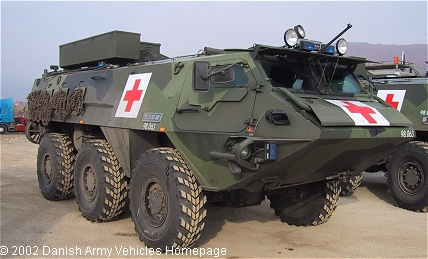
Posted on 09/05/2003 2:04:55 PM PDT by archy
Israel Looks to New of Army Vehicles
GAVIN RABINOWITZ
Associated Press
JERUSALEM - To boost the maneuverability of its army, particularly in the urbanized West Bank and Gaza Strip, the Israeli military plans to equip its troops with armored vehicles that use wheels instead of tracks, Israeli officials said.
The military will buy 500 American-made Stryker LAV-3 armored personnel carriers for its soldiers, the Haaretz daily newspaper said.
The $750 million purchase of the Strykers will be funded by America's annual defense aid to Israel, Haaretz said. The Strykers, expected to be in use within seven years, would replace the old M-113 APCs the army has been using since the early 1970s.
An Israeli military official, speaking on condition of anonymity, said the army also was set to receive and equip its special forces with an armored version of the U.S.-made Humvee fighting vehicle in the coming weeks.
The army also is considering buying a German-made APC, called the Dingo, for use in the West Bank and Gaza Strip, another Israeli source said. Such a move would be controversial in Germany, which has refused similar requests in the past.
The German defense ministry could not comment but noted that such a sale would require government approval. The U.S. Embassy in Tel Aviv declined comment. The Israeli military spokesman's office said final decisions had not yet been made.
The Humvee, the Stryker and the Dingo all have wheels while the older APCs run on tracks. In the past, the army needed tracked vehicles to reach the battleground over harsh terrain.
But the tracked vehicles cannot use today's network of roads for rapid deployment, needing the help of tank carriers.
The Stryker, with a maximum speed of 65 mph, also fits the military's combat doctrine that calls for an integration of infantry and armored forces. The old M-113 proved itself slow in keeping up with Israel's modern tanks.
The change in focus is a result of both the U.S. army's conclusions from the two Gulf wars and Israel's own experiences during the 33 months of bitter fighting with the Palestinians that often saw cumbersome APCs operating in the narrow alleyways of the West Bank and Gaza.
According to the Israeli source, the army also is considering attempting to purchase the German-made Dingo APC for its mechanized infantry units that operate exclusively in the West Bank and Gaza.
The Dingo is said to offer its crew unparalleled protection from mines and roadside bombs for its class of armored vehicle.
A similar Israeli request in September caused an outcry in Germany, which has strict guidelines for exporting armaments to conflict areas.
The company that makes the Dingos, Krauss-Maffel Wegmann, said they have no knowledge of Israeli interest in the vehicles.
I'll see what can be found in the German English-language press as well.
-archy-/-



Don't you have to pass the 6th grade in order to become a headline writer anymore?
All Your New Are Belong to Us!
All Your Army Vehicle too.
Make your time.
A modernization program for the M113 fleet would be in order. The M113A3 with improved suspension and upgrades to power train can keep pace with the Abrams and nothing in Israel can compare to the M1A2. If I was in Israel I would want to see the results of any live fire testing conducted at APG. In fact, I might want to buy a couple of Strykers and see how they withstand RPG's, and don't let them put the add on armor on the vehicles. Heck, it is almost 3 feet wider with that junk on it. Can you imagine trying to maneuver through a village with a vehicle that is 14 to 15 feet wide? Needs to have ground guides just to get around. Try that with snipers in the meighborhood.
In an urban scenario, wouldn't there be fire from behind and above, as well? It looks to me that a Dingo type vehicle might be just as effective as the Stryker and a lot handier (and cheaper!) I frankly would hate to ride either one into an hostile alley.
I'm getting the picture that in urban warfare, the best transportation is sneakers, the best weapons: RPGs, scoped sniper rifles (day and night), and AK74s. All of which favor the homies, and not the visiting team. Perhaps we ought to do what we do best, and make sure potential enemies do not have any urban areas left. That's what these vehicles are apparently best suited for: sitting on a hillside 2 miles away, watching the AF reorganize hostile urban areas and the Army smooth out the rubble with artillery.
Btw, the PG-7 warhead of the RPG-7D and RPG-7V is a HEAT warhead, not HESH, though the various later thermobaric warhead rounds for the RPG developed by the Russians and Bulgarians can be expected to have an effect similar to that of a HESH round. And the Stryker's armor, necessarily brittle to obtrain hardness, has been fractured when a demolition charge carried externally on an engineer vehicle configured Stryker detonated during live fire testing. Accordingly, it appears likely that the Stryker will be particularly vulnerable to such projectiles and will need anti-spall linings...more weight to go with the additional 2 tons from the add-on armor; it's now over 20 tons. And that means even less room inside, too...
It's not much better for those aboard a tracked vehicle when a track is knocked off or apart than it is for those on wheels, but some tracks can at least roll away on their road wheels out of the kill zone, particularly if on a paved road or city street.
In an urban scenario, wouldn't there be fire from behind and above, as well? It looks to me that a Dingo type vehicle might be just as effective as the Stryker and a lot handier (and cheaper!) I frankly would hate to ride either one into an hostile alley.
Probably the real most recent experts on the use of armored vehicles in urban areas was the Brits during the time of their occupation of Northern Ireland. They required an enormous variety of differing types, both wheeled and tracked, and they also faced the RPG-7 and similar launchers, though not in as great a number as our forces may encounter. Everything from armoured Land Rovers to six-wheeled armoured cars mounting a 76mm main gun were used, as well as light 4-wheel armoured cars and armored police *paddy wagons.* Rifle fire and Molotov cocktails were the primary concerns, though not at all the only ones.
In addition to the Dingo, check out the six-wheeled Finnish Sisu, similar, but superior in many ways.
The point, though, is that when you do find yourself rolling into a hornets nest in a blind alley [or a crossroads where you may be in an X-shaped ambush taking fire from all sides] you roll right out again if you can. And you think a lot about command-detonated mines while you're doing so, as well as backup RPGs.




I'm getting the picture that in urban warfare, the best transportation is sneakers, the best weapons: RPGs, scoped sniper rifles (day and night), and AK74s. All of which favor the homies, and not the visiting team. Perhaps we ought to do what we do best, and make sure potential enemies do not have any urban areas left. That's what these vehicles are apparently best suited for: sitting on a hillside 2 miles away, watching the AF reorganize hostile urban areas and the Army smooth out the rubble with artillery. IMHO, the best weapons aboard a Stryker are its radios and and digital C3 gear and a laser target designator. But the point is, that if you're facing a determined enemy mounted on those sneakers, with RPG-7s [or worse; there ARE more effective handheld AT weapons] SVD snipers' rifles and AKs, you need troops on the ground on foot to deal with them, NOT riding around in vehicles....though fast response teams will be required, as they were in Mogadishu when the Rangers were slaughtered.
But those response teams had better be expecting to be suckered into an ambush. Because a strike on an isolated patrol is how such forces are pulled out of their defensive perimeters to a nice location where forces thought to be sufficient to deal with them will be waiting.
The accompanying vehicles support the grunts on the ground; they're not just a taxi for them. When we forget that, we'll pay.
Someone's translation into the English language was a little less than seamless. I wonder if the original was Hebrew, or Russian, very possibly one heavily accented with the other....
Be grateful you're not supporting his 17-year-old wife, as well.
And that he's not yet in the military, and about to be deployed into Iraq in a Stryker-equipped unit.
-archy-/-
Disclaimer: Opinions posted on Free Republic are those of the individual posters and do not necessarily represent the opinion of Free Republic or its management. All materials posted herein are protected by copyright law and the exemption for fair use of copyrighted works.